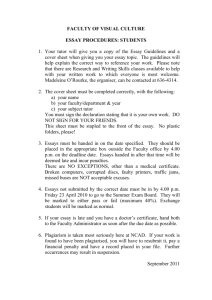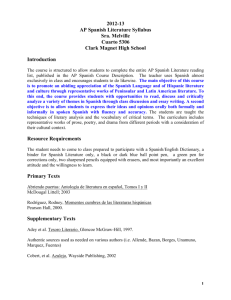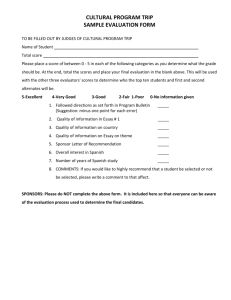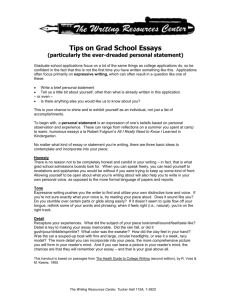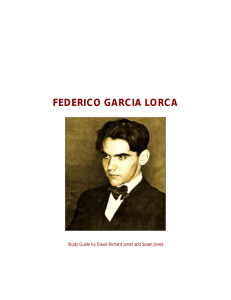AP Spanish Literature Syllabus 2012-2013
advertisement
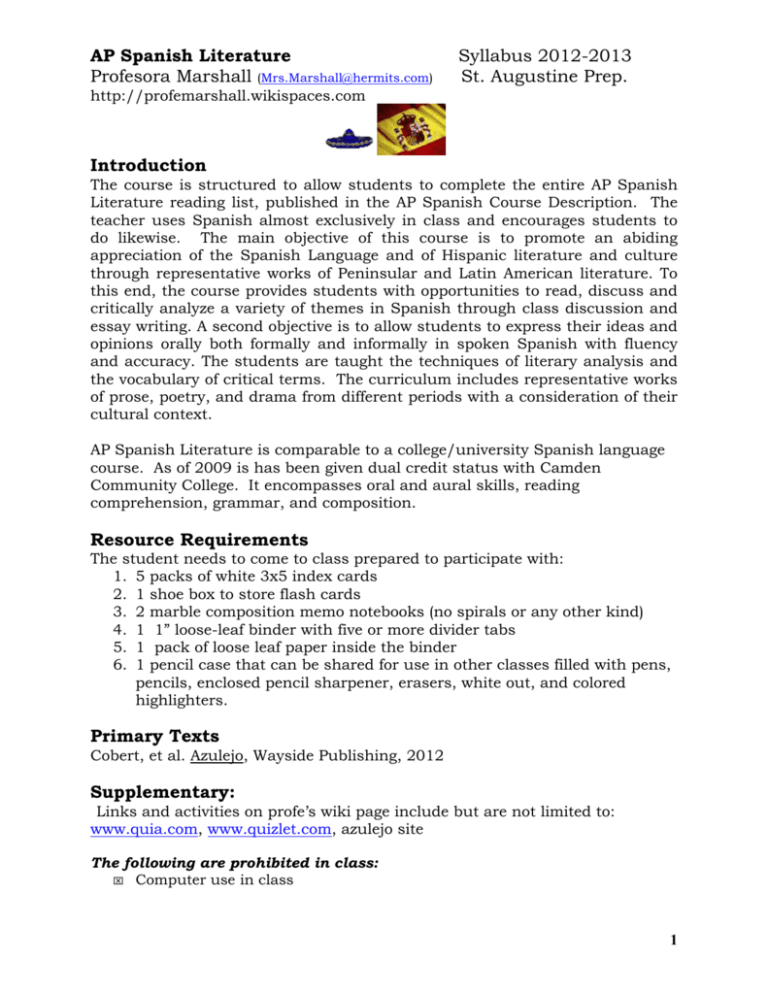
AP Spanish Literature Profesora Marshall (Mrs.Marshall@hermits.com) Syllabus 2012-2013 St. Augustine Prep. http://profemarshall.wikispaces.com Introduction The course is structured to allow students to complete the entire AP Spanish Literature reading list, published in the AP Spanish Course Description. The teacher uses Spanish almost exclusively in class and encourages students to do likewise. The main objective of this course is to promote an abiding appreciation of the Spanish Language and of Hispanic literature and culture through representative works of Peninsular and Latin American literature. To this end, the course provides students with opportunities to read, discuss and critically analyze a variety of themes in Spanish through class discussion and essay writing. A second objective is to allow students to express their ideas and opinions orally both formally and informally in spoken Spanish with fluency and accuracy. The students are taught the techniques of literary analysis and the vocabulary of critical terms. The curriculum includes representative works of prose, poetry, and drama from different periods with a consideration of their cultural context. AP Spanish Literature is comparable to a college/university Spanish language course. As of 2009 is has been given dual credit status with Camden Community College. It encompasses oral and aural skills, reading comprehension, grammar, and composition. Resource Requirements The student needs to come to class prepared to participate with: 1. 5 packs of white 3x5 index cards 2. 1 shoe box to store flash cards 3. 2 marble composition memo notebooks (no spirals or any other kind) 4. 1 1” loose-leaf binder with five or more divider tabs 5. 1 pack of loose leaf paper inside the binder 6. 1 pencil case that can be shared for use in other classes filled with pens, pencils, enclosed pencil sharpener, erasers, white out, and colored highlighters. Primary Texts Cobert, et al. Azulejo, Wayside Publishing, 2012 Supplementary: Links and activities on profe’s wiki page include but are not limited to: www.quia.com, www.quizlet.com, azulejo site The following are prohibited in class: Computer use in class 1 Cell phones visible or audible Food or drink of any kind Timeline The required reading list is organized from a chronological perspective and fulfills the course requirement to complete the entire AP Spanish Literature Reading list. By adhering to this timeline, the students get a whole view of the historical traditions and cultural customs and mores existing on both sides of the Spanish-speaking world. WE WILL NEED TO MOVE RAPIDAMENTE!!!! Basic Class Procedure Every day there will be either a quiz or an “ejercicio de precalentamiento” at the beginning of class. Be seated immediately and review for the quiz or complete the warm-up in your blue books. Every day a student will make a presentation to the class. Assignments will be given the first day of the week the class meets. You are on call to give the presentation any day after that. First Semester Course Overview The course begins with a general grammar review of the first four years and a comprehensive introduction to the terminology necessary for literary analysis in all genres (prose, poetry, and drama). This includes literary movements in Hispanic literature from the medieval period through the latest literary trends. During this first month students are taught how to structure their analytical essay and are shown how to use transition words, conjunctions, chronological words, words for making comparisons and contrasts, and vocabulary words to summarize. Major themes discussed in the first quarter: Honor and dishonor, the tenacity of the individual, man verus nature, immortality/mortality, exploration and discovery, the challenges/dreams of the individual, social and political criticism, divine justice, and carpe diem. September/October: La Edad Media (Siglos XIV-XV) “El Conde Lucanor”. Don Juan Manuel “Romance de la pérdida de Alhama”. Anónimo “Romance del Conde Arnaldos”. Anónimo El Siglo de Oro (Siglos XVI-XVII-Renacimiento y Barroco) “En tanto que de rosa y azucena, Soneto XXIII”. Garcilaso de la Vega “Mientras por competir por tu cabello. Soneto CLXVI’. Luis de Góngora “Miré los muros de la patria mía, Salmo XVII”. Francisco de Quevedo “En perseguirme, Mundo, ¿qué interesas?” Sor Juana Inés de la Cruz “Hombres necios que acusáis” Sor Juana Inés de la Cruz “Segunda carta de relación de Cortés”. Hernán Cortés “Visión de los vencidos”. Miguel León-Portilla Lazarillo de Tormes. Prólogo,Tratados: 1,2,3,7 Anónimo 2 El ingenioso hidalgo don Quijote de la Mancha. Primera parte, Capítulos I, II, III, IV, V, VIII, IX y segunda parte Capítulo LXXIV. Miguel de Cervantes El burlador de Sevilla y convidado de piedra. Tirso de Molina Naufragios. Capítulos XII, XX, XXI, XXII Cabeza de Vaca November: Romanticismo (Siglo XIX) “Vuelva Ud. Mañana”. Mariano José de Lara “Canción del pirata”. José de Espronceda “En una tempestad”. José María Heredia “El alacrán de Fray Gómez”. Ricardo Palma “No digáis que agotado su tesoro”. Gustavo Adolfo Bécquer “Yo soy ardiente, yo soy morena”. Bécquer “Volverán las oscuras golondrinas, Rima LIII”. Bécquer Major themes discussed in the second quarter: Individual freedom, love and passion, the loss of innocence, the role of women in society (double standards), oppression, sexual frustration, the relationships between parent and child, social and political criticism, and carpe diem. December: Realismo y Naturalismo (Siglo XIX) “Adiós, Cordera”. Leopoldo Alas Clarín “Las media rojas”. Emilia Pardo Bazán “El hijo”. Horacio Quiroga “Las Ataduras” Carmen Martín Gaite Modernismo “Nuestra América”. José Martí “Dos patrias”. José Martí “Yo soy un hombre sincero”. José Martí “Canción de otoño en primavera”. Rubén Darío “A Roosevelt”. Darío “Lo fatal”. Darío “Tu me quieres blanca”. Alfonsina Storni “Peso ancestral”. Storni “A Julia de Burgos”. Julia de Burgos Second Semester Course Overview The course continues through the enrichment of vocabulary to include literary devices used in poetry and prose. Students compose expository passages that express analysis of a theme or illustrate the use of poetic devices. These practice essays are assigned after each theme is thoroughly analyzed in class. The focus is mainly on Hispanic literature in the spring. Major themes discussed in the third quarter: Religion, sexual frustration, family relationships, the role of women in society, the decadence of the “established order,” social criticism, the treatment of the gypsy in Spanish society, individual liberty, the role of the strong woman, justice/injustice, and identity. January: Autores de la Generación del 98 (Siglos XX y XXI) San Manuel Bueno, mártir. Miguel de Unamuno. “He andado muchos caminos”. Antonio Marchado 3 “La primavera besaba”. Marchado “Caminante, son tus huellas”. Marchado February & March: Vanguardismo “Romance de la luna, luna”. Federico García Lorca “Romance sonámbulo”. Lorca “Romance de la pena negra”. Lorca “La monja gitana”. Lorca “Prendimiento de Antañito el Camborio”. Lorca “Muerte de Antañito el Camborio”. Lorca La casa de Bernarda Alba. Lorca “Sensemayá”. Nicolás Guillén. “Balada de los dos abuelos”. Guillén “Me gustas cuando callas”. Pablo Neruda “Walking Around”. Neruda “Oda a la alcachofa”. Neruda El delantal blanco. Sergio Vodanovik Major themes discussed in the fourth quarter: The psychological development of the individual, the power of words, identity, immortality/mortality, class struggle, social and political criticism, familial relationships, existentialism, fantasy versus reality (magic realism), parallel/simultaneous time periods, the “flaws” in human character (egoism, arrogance, vengeance, envy, pride, greed, hatred, grief, etc). April: El “Boom” de la narrativa hispanoamericana “La muerte y la brújula”. Jorge Luis Borges “El sur”. Jorge Luis Borges “Borges y yo”. Jorge Luis Borges “¿No oyes ladrar los perros?” Juan Rulfo “La continuidad de los parques”. Julio Cortázar “La noche boca arriba”. Cortázar “Chac Mool”. Carlos Fuentes “La siesta de martes”. Gabriel García Márquez “La viuda de Montiel”. García Márquez “Un señor muy viejo con alas enormes”. García Márquez “El ahogado más hermoso del mundo”. García Márquez “Un día de estos”. García Márquez “La prodigiosa tarde de Baltasar”. García Márquez “Historia del hombre que se convirtió en perro”. Osvaldo Dragún May: La voz femenina en la literatura contemporánea Literatura chicana en EE.UU. “Autorretrato”. Rosario Castellanos “Dos palabras”. Isabel Allende “Como la vida misma”. Rosa Montero “Peso ancestral”. Alfonsina Storni “A Julia de Burgos”. Julia de Burgos “Mujer negra”. Nancy Morejón “Mi caballo mago”. Sabine Ulibarrí “… y no se lo tragó la tierra”. Tomás Rivera “La noche buena”. Tomás Rivera *Repaso general para el examen de AP literatura (autores, títulos, temas, recursos poéticos, terminología de la narración, etc. 4 Teaching Strategies Student Activities The course teaches students the techniques of literary analysis and a basic vocabulary of critical terms. I. Graphic Organizers: After each reading, students fill out a graphic organizer or “Ficha” depending on the genre: Prosa (Narración) Título, autor, época, contexto cultural, temas, personajes, resumen del argumento, desarrollo, ambiente, lenguaje, culminación y desenlace, punto de vista, tono. Poesía Título, poeta, época, contexto cultural, temas, versificación, ritmo, rima, arte menor o mayor, estrofas, breve resumen en prosa, imágenes sobresalientes, imágenes sensoriales, recursos poéticos (paradoja, epíteto, prosopopeya, polisíndeton, encabalgamiento, etc.) Obras de teatro Título, autor, época, contexto cultural, temas, personajes, resumen del argumento, desarrollo, ambiente, lenguaje, culminación y desenlace, tono, acotaciones. The students use these “fichas” as a study guide for review prior to the exam. Throughout the year these organizers help the students to write analytical essays. At the end of each semester, teacher and students compile a list of authors that have expressed the same themes and fill in another organizer such as the one below: TEMAS: AUTORES AUTORES AUTORES AUTORES La inmortalidad El egoism La venganza Las relaciones familares La indivualidad Other graphic organizers that help students comprehend are: El fluir de conciencia La terminlogía de la narración La rueda del saber Diagramas Venn Los mapas semánticos La mente abierta (el doblamiento) Las caras de los persosnajes La secuencia de eventos El cartelón de historia 5 II. Student Essays Students are assigned essays designed in the format used on the AP literature Exam. Some of these are done at home and some are timed essays in class. In their essays, they analyze prose or poetry, emphasizing the imagery and literary terms, and demonstrate how the author reflects the time period and themes in his/her writings. Students write a first draft and then peer critique and peer edit each other’s work using the AP scoring guidelines from AP Central. They then write a second draft, which is also subject to a second round of peer critiquing from which they write their final draft. Throughout the course students practice writing the three types of questions on the exam: poetic analysis, thematic analysis, and text analysis. III. Other Student Activities 1. Individual and Group Oral Presentations (as listed below in numbers 24): 2. Internet investigations on selected authors wherein students investigate the historical background of the author’s country and life, activities and aspirations, and literary figures/movements that influenced their writings. This is presented either with a Power Point presentation or with posters. 3. Perform selected scenes from different theatrical works. 4. Poster creations: i.e. poetry or storyboards that include a title, illustration, quote, and thematic analysis. Each student will create a poster for each work and present it the class. 5. Pre and Post discussion in Spanish dealing with the themes presented in the selected readings as they appear in the text “Azulejo”. Prior to the exam as an extensive review, students fill out a graphic organizer that deals specifically with the major themes associated with the authors such as: la opresión de la mujer, la violencia, el realismo mágico, el determinismo social, el individualismo, el desarrollo psicológico, relaciones familiares, etc. Student Evaluation I. Each semester the students are required to write a number of essays inside and outside of class. The writing prompts for these essays are modeled on the format of the AP Spanish Literature Exam. The essays done in class are timed writings and are critiqued by the teacher. The essays done outside of class go through at least two rounds of peer review before submitting the final copy. In their essay writing, students must demonstrate proper usage of literary terms and and/or poetic devices. II. Other means of assessing students during the year are: 6 Short quizzes Post-reading comprehension questions Oral presentations on poetry, authors’ lives and cultural context Vocabulary quizzes on literary terms and poetic devices Ongoing assessment of portfolios, organizers, and “fichas” Semester finals using questions from previous AP Exams III. At the end of each semester students take a final exam based on the previously released AP Spanish Literature exam. This final consists of questions in multiple-choice format and includes one of the three essay prompts on the exam: thematic analysis, poetic analysis, or text analysis. IV. At the end of each semester, authentic assessment includes a reflective portfolio. This enables the students to synthesize and analyze their own work and academic growth throughout the entire year. Grading 15% Class work and homework Notebooks and binders will be periodically graded. All assignments must be turned in on time. All exercises to be completed in class must be completed outside of class on your own time. It is your job to make sure all work is completed. Ten points will be deducted per day for late assignments. You are responsible for making up any notes or work completed in class if you are absent. 20% Quizzes (announced and unannounced, including notebook quizzes) 20% Participation (20 points needed each week for 100%) Extra points for acting Points deducted for conduct, tardiness or forgetfulness 20% Projects, presentations, posters, conversations & skits (written & spoken) 25% Tests Chapter tests: Chapter tests cover everything from the chapter, including both vocabulary, grammar, stories and culture. Tests will always include listening, reading comprehension, an essay, and face-to-face interview with Profe. The Honor Code will be handwritten by you on all tests and quizzes. Ten points will be deducted from any paper or blue book in which it does not appear. After September, the honor code will be written by you in Spanish: Como miembro de la hermandad de la Preparatoria de San Agustín, prometo ser una persona de integridad. Ni daré ni recibiré ninguna ayuda no autorizada en cualquier trabajo académico. You will be peer grading quizzes and homework assignments. The HONOR CODE applies. If a peer asks you to cheat for him and you do, you are BOTH in violation. Before you begin peer grading you will write “Doy mi palabra de honor” and sign your name on your peer’s paper. 7 Procedure for labeling assignments For labeling homework or any other assignments, please write your name, date, period, and assignment in the upper right corner of your paper and the words, “Doy mi palabra de honor” (“I give my word of honor”). You will also write this promise on each page of the blue book dictado quizzes, By writing this on your paper, you are giving your word of honor that you have not given or received specific information related to the quiz or test. A Note About Translation Programs Do not use any computer translation programs for work in this class. Any use of these programs will be considered a violation of the Honor Code and will be penalized as such. Translation programs do not work and are immediately detectable. They are no substitution for learning a language. 8 Grading Rubric for Essays in Spanish All levels of composition & oral presentations are graded on a 15 point total scale according to AP essay scoring guidelines: 5 points for Task Completion, 5 points for Task Development, and 5 points for Language (Output Checklist). Task Completion* 5 - Task handed in on time and all task components completed 4 - Task handed in on time and most task components completed 3 - Task handed in on time and partial task completion 3 - Task handed in late with unexcused absence and all tasks completed 2 - Task handed in on time but minimal task components completed 2 - Task handed in late with unexcused absence and most/partial task components completed 1 - Task handed in on time but topic is not addressed, misunderstood, and/or irrelevant 0 - Task is not handed in Other: Task Development* 5 - Demonstrates Superiority: A very well-developed essay that demonstrates insight and analytic ability. Shows originality. It virtually has no irrelevant or erroneous information. It leaves no doubt in the reader's mind that the student possesses a superior understanding of the nature and significance of the works read and/or viewed. 4 - Demonstrates Competence: A well-developed essay that shows some insight and analytic ability. Analysis outweighs description, and any plot summary present serves to illustrate the nature and significance of the works read/viewed. May contain some erroneous information, but errors do not affect the overall quality of the essay. Reader must make some inferences because the response or the comparison/contrast is not always sufficiently explicit. 3 - Suggests Competence: Student basically understands the question, but the essay is not always well-focused. There may be an attempt at analysis; the nature and the significance of the works read/viewed may not be addressed. Relatively superficial commentary. Plot summary outweighs analysis. May contain significant errors of fact or interpretation. 2 - Suggests Lack of Competence: Poorly organized essay; focus wanders. It's sketchy. Student has limited understanding of the question/task. May consist almost entirely of plot summary with no analysis. Irrelevant comments may predominate. It is possibly a prepared overview of the author with limited connection to the topic. May 9 contain major errors or be so general as to suggest that the student is unable to deal completely with the question. 1 - Demonstrates Lack of Competence: Essay is chaotic, confused, incorrect. Reader is left with the certainty that the student has not understood the question/prompt or the authors' texts. 0 - Response is on task but is so brief or so poorly written as to be meaningless. It's written in English. It's a blank page r response is completely off-task (obscenity, nonsense poetry, drawings, letter to the reader, etc.) Other: Language - Output Checklist*1 Language pattern of errors = -1 pt. ; 2 patterns = -2 pts.; 3 patterns = -3 pts; etc. A check means that the student needs to work on/correct these errors. 1. Ser vs. Estar 2. Por vs. Para 3. Imperfect vs. Preterite 4. Indicative vs. Subjunctive 5. Subject/Verb Agreement 6. SOT (Sequence of Tenses) 7. Gender/Number Agreement 8. Passive vs. Active Voice 9. Personal "a" 10. IOP (Indirect Object Pronoun) 11. DOP (Direct Object Pronoun) 12. 13. RP (Reflexive Pronoun) Spelling 14. Accents 15. Register (Tú vs. Usted) 16. Awkward expression Language Interference/Literal Translation 17. 18. Vocabulary (Too thin, apply new) Suspected Mis-use of Online Translation Site: Internet Spanish/English Dictionaries are permitted for looking up individual words. Copying and pasting the thoughts of others to help write your essay without giving due credit or proper format (footnotes, bibliography, MLA) can result in expulsion from school due to plagiarism, which is a serious academic and legal offense. 19. 20. Other: Structure* Thesis statement Introduction/connect to Body Topic sentence for Body/developing Paragraph(s) 10 Body/developing Paragraph(s) Re-state thesis in Concluding paragraph Conclusion + original thought (personal statement relating to theme/thesis) Other: Style/Additional Comments* 11
